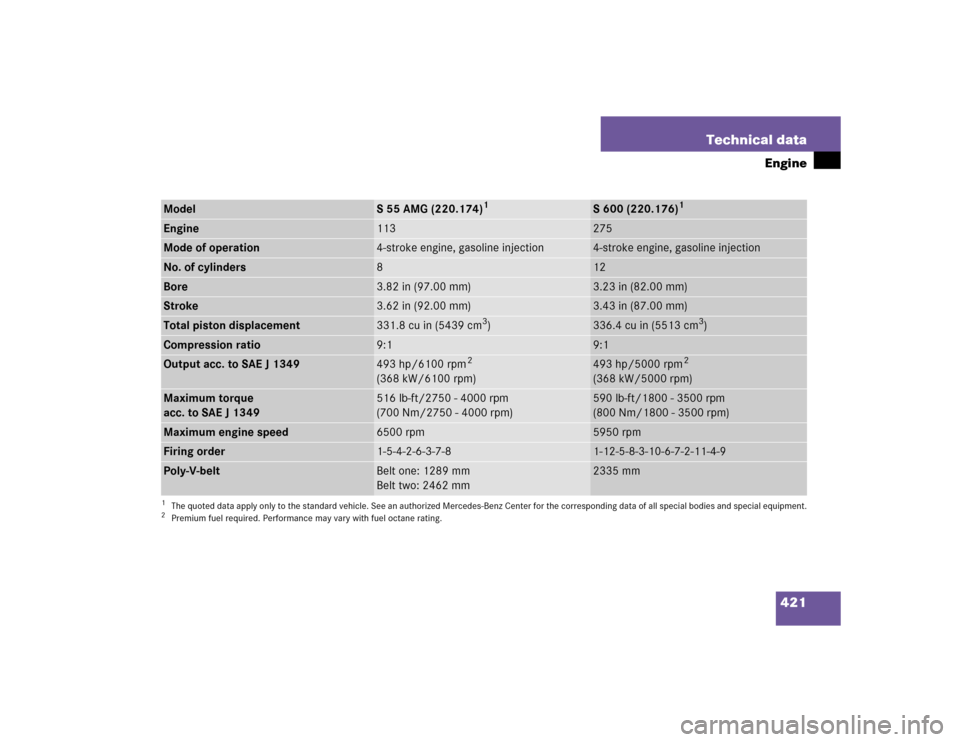Page 327 of 474

325 Operation
Tires and wheels
Rotating tires
Tire rotation can be performed on vehicles
with tires of the same dimension all
around. If your vehicle is equipped with
tires of the same dimension all around,
tires can be rotated, observing a a
front-to-rear rotation pattern that will
maintain the intended rotation (spinning)
direction of the tire (
�page 299).
In some cases, such as when your vehicle
is equipped with mixed-size tires (different
tire dimension front vs. rear), tire rotation
is not possible.If applicable to your vehicle's tire configu-
ration, tires can be rotated according to
the tire manufacturer's recommended in-
tervals in the tire manufacturer's warranty
pamphlet located in your vehicle literature
portfolio. If none is available, tires should
be rotated every 3 000 to 6 000 miles
(5 000 to 10 000 km), or sooner if neces-
sary, according to the degree of tire wear.
The same rotation (spinning) direction
must be maintained (
�page 299).
Rotate tires before the characteristic tire
wear pattern becomes visible (shoulder
wear on front tires and tread center wear
on rear tires).
Thoroughly clean the mounting face of
wheels and brake disks, i.e. the inner side
of the wheels/tires, during each rotation.
Check for and ensure proper tire inflation
pressure.For information on wheel change, see the
“Practical hints” section (
�page 398).
Warning!
G
Rotate front and rear wheels only if the tires
are of the same dimension.
If your vehicle is equipped with mixed-size
tires (different tire dimensions front vs.
rear), tire rotation is not possible.
Warning!
G
Have the tightening torque checked after
changing a wheel. Wheels could become
loose if not tightened with a torque of
110 lb-ft (150 Nm).
Only use genuine Mercedes-Benz wheel
bolts specified for your vehicle's rims.
Page 404 of 474

402 Practical hintsFlat tireLowering the vehicle�
Lower vehicle by turning crank coun-
terclockwise until vehicle is resting ful-
ly on its own weight.
�
Remove the jack.
1 - 5 Wheel bolts
�
Tighten the five wheel bolts evenly, fol-
lowing the diagonal sequence illustrat-
ed (1 to 5), until all bolts are tight.
Observe a tightening torque of
110 lb-ft (150 Nm).
�
Before storing the jack in the trunk, it
should be fully collapsed, with handle
folded in.
�
Place the wheel bolt wrench, alignment
bolt and jack back in the vehicle tool kit
in the trunk and close the covering lid.Replacing jack support tube cover
�
Slide tongue of cover under the upper
edge of the tube opening.
�
Applying even pressure, press cover
until it snaps into place. Be careful not
to damage the locking tabs or clamp
the plastic retaining strap.
Warning!
G
Have the tightening torque checked after
changing a wheel. The wheels could come
loose if they are not tightened to a torque of
110 lb-ft (150 Nm).
!You can also screw the faulty wheel
down into the spare wheel well in the
trunk.
Do not activate the tire inflation pres-
sure monitor* until the depressurized
tire is no longer in the vehicle.
Page 422 of 474

420 Technical dataEngineModel
S 430 (220.070, 220.170)
1
S 430 4MATIC (220.183)
1
1The quoted data apply only to the standard vehicle. See an authorized Mercedes-Benz Center for the corresponding data of all special bodies and special equipment.
S 500 (220.175)
1
S 500 4MATIC (220.184)
1
Engine
113
113
Mode of operation
4-stroke engine, gasoline injection
4-stroke engine, gasoline injection
No. of cylinders
8
8
Bore
3.54 in (89.90 mm)
3.82 in (97.00 mm)
Stroke
3.31 in (84.00 mm)
3.31 in (84.00 mm)
Total piston displacement
260.3 cu in (4266 cm
3)
303.0 cu in (4966 cm
3)
Compression ratio
10:1
10:1
Output acc. to SAE J 1349
275 hp/5750 rpm
2
(205 kW/5750 rpm)
2Premium fuel required. Performance may vary with fuel octane rating.
302 hp/5600 rpm
2
(225 kW/5600 rpm)
Maximum torque
acc. to SAE J 1349
295 lb-ft/3000 - 4400 rpm
(400 Nm/3000 - 4400 rpm)
339 lb-ft/2700 - 4250 rpm
(460 Nm/2700 - 4250 rpm)
Maximum engine speed
6000 rpm
6000 rpm
Firing order
1-5-4-2-6-3-7-8
1-5-4-2-6-3-7-8
Poly-V-belt
2380 mm
2380 mm
Page 423 of 474

421 Technical data
Engine
Model
S 55 AMG (220.174)
1
S 600 (220.176)
1
Engine
113
275
Mode of operation
4-stroke engine, gasoline injection
4-stroke engine, gasoline injection
No. of cylinders
8
12
Bore
3.82 in (97.00 mm)
3.23 in (82.00 mm)
Stroke
3.62 in (92.00 mm)
3.43 in (87.00 mm)
Total piston displacement
331.8 cu in (5439 cm
3)
336.4 cu in (5513 cm
3)
Compression ratio
9:1
9:1
Output acc. to SAE J 1349
493 hp/6100 rpm
2
(368 kW/6100 rpm)
493 hp/5000 rpm
2
(368 kW/5000 rpm)
Maximum torque
acc. to SAE J 1349
516 lb-ft/2750 - 4000 rpm
(700 Nm/2750 - 4000 rpm)
590 lb-ft/1800 - 3500 rpm
(800 Nm/1800 - 3500 rpm)
Maximum engine speed
6500 rpm
5950 rpm
Firing order
1-5-4-2-6-3-7-8
1-12-5-8-3-10-6-7-2-11-4-9
Poly-V-belt
Belt one: 1289 mm
Belt two: 2462 mm
2335 mm
1The quoted data apply only to the standard vehicle. See an authorized Mercedes-Benz Center for the corresponding data of all special bodies and special equipment.2Premium fuel required. Performance may vary with fuel octane rating.
Page 429 of 474
427 Technical data
Electrical system
�Electrical system
Model
S 430, S 500
S 55 AMG
S 600
Generator (alternator)
14 V/150 A
14 V/180 A
14 V/220 A
Starter motor
12 V/1.7 kW
12 V/1.7 kW
12 V/1.7 kW
Battery
12 V/95 Ah
12 V/95 Ah
12 V/95 Ah
Spark plugs
Bosch F 8 DPP 332
NGK PFR 5 R-11
NGK IL FR 6 A
NGK IFR 6Q-G
Electrode gap
0.039 in (1.0 mm)
0.031 in (0.8 mm)
0.028 in (0.7 mm)
Tightening torque
15 – 22 lb-ft (20 – 30 Nm)
18 – 22 lb-ft (25 – 30 Nm)
15 – 22 lb-ft (20 – 30 Nm)
Page 443 of 474

441 Technical terms
Power train
Collective term designating all compo-
nents used to generate and transmit
motive power to the drive axles, includ-
ing:
�
Engine
�
Clutch/torque converter
�
Transmission
�
Transfer case
�
Drive shaft
�
Differential
�
Axle shafts/axles
Program mode selector switch
Used to switch the automatic transmis-
sion between standard operationS and
comfort operationC.
S 55 AMG with steering wheel gearshift
control and manual shift program: in
addition toS andC (see above), you
can useM for manual operation.REST
(Residual engine heat utilization)
Feature that uses the engine heat
stored in the coolant to heat the vehi-
cle interior for a short time after the en-
gine has been turned off.
Restraint systems
Seat belts, belt tensioners, air bags
and child restraint systems. As inde-
pendent systems, their protective func-
tions complement one another.
RON
(R
esearch O
ctane N
umber)
The Research Octane Number for gaso-
line as determined by a standardized
method. It is an indication of a gaso-
line's ability to resist undesired detona-
tion (knocking). The average of both
the ->MON (Motor Octane Number)
and RON (Research Octane Number) is
posted at the pump, also known as AN-
TI-KNOCK INDEX.Shift lock
When the vehicle is parked, this lock
prevents the transmission selector le-
ver from being inadvertently moved out
of positionP without the SmartKey
turned and the brake pedal depressed.
SRS
(S
upplemental R
estraint S
ystem)
Seat belts, emergency tensioning de-
vice and air bags. Though independent
systems, they are closely interfaced to
provide effective occupant protection.
Page 444 of 474

442 Technical termsTele Aid System
(T
elematic A
larm I
dentification on
D
emand)
The Tele Aid system consists of three
types of response: automatic and man-
ual emergency, Roadside Assistance
and information. Tele Aid is initially ac-
tivated by completing a subscriber
agreement and placing an acquain-
tance call.
The Tele Aid system is operational pro-
vided that the vehicle’s battery is
charged, properly connected, not dam-
aged and cellular and GPS coverage is
available.
Telematics*
A combination of the terms “telecom-
munications” and “informatics.”
Tightening torque
Force times lever arm (e.g. a lug
wrench) with which threaded fasteners
such as wheel bolts are tightened.Tire speed rating
Part of a tire designation; indicates the
speed range for which a tire is ap-
proved.
Traction
Force exerted by the vehicle on the
road via the tires.
VIN
(V
ehicle I
dentification N
umber)
The number set by the manufacturer
and stamped on the body to uniquely
identify each vehicle produced.
Voice control system*
Voice control system for car phones,
portable cell phones and audio sys-
tems (radio, CD, etc.).
Page 468 of 474

466 IndexSun visors 190
Supplemental Restraint System
(SRS) 441
Suspension tuning
For regular driving style 232
For sporty driving style 232
Setting 231
Switching off
Automatic central locking (control
system) 168
Engine 57
ESP 83
Hazard warning flasher 136
Headlamps 57
Switching on
Automatic central locking (control
system) 168
ESP 84
Front fog lamps 134
Front lamps 131
Hazard warning flasher 136
Headlamps 50
High beams 135
Parking lamps 131
Rear fog lamp 134
Windshield wipers 52Symbol (Distronic*)
Distance warning function* 156
Synchronizing
ESP 352
Power windows 209
Tilt/sliding sunroof 213
T
Tachometer 142
Overspeed range 142
Tachometer display
Displaying gear range 176
Tail lamps
Cleaning 332
Replacing bulbs 390, 395
Tar stains 331
Tele Aid 255
Emergency calls 256
Information 260
Initiating an emergency call
manually 257
Messages in display 370
Remote door unlock 262
Roadside assistance 258
Stolen Vehicle Recovery
services 263
System self-check 256Tele Aid System 255
Upgrade scenario 261
Tele Aid button 29
Tele Aid System 442
TeleAid
Messages in display 370
Telematics* 442
Telephone holder*
Storage compartment in front of
armrest 247
Telephone* 254
Answering a call 154
Dialing a number from the phone
book 154
Ending a call 154
Hands-free microphone 29
Loading phone book* 154
Messages in display 370
Operating 153
Redialing 155
Temperature
Display mode 163
Setting units in display 163
Tires 306
Tie-down hooks (Trunk) 241
Tightening torque 442